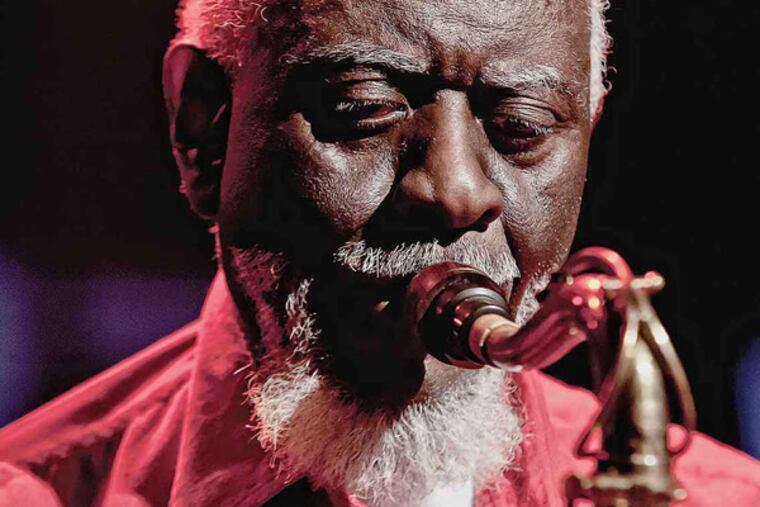Pharoah Sanders elevates Coltrane, and himself
While John Coltrane's influence is pervasive in the last half-century of jazz history, only tenor saxophonist Pharoah Sanders could be considered a Coltrane apostle. Sanders was a member of the saxophonist's band during the last two years of Coltrane's life as he pushed into the furthest reaches of the avant-garde, and Sanders continued making his own music in a similar vein, combining explosive freedom and spiritual purpose.

While John Coltrane's influence is pervasive in the last half-century of jazz history, only tenor saxophonist Pharoah Sanders could be considered a Coltrane apostle. Sanders was a member of the saxophonist's band during the last two years of Coltrane's life as he pushed into the furthest reaches of the avant-garde, and Sanders continued making his own music in a similar vein, combining explosive freedom and spiritual purpose.
Leading a quartet at Montgomery County Community College on Saturday, the night before his 73d birthday, Sanders continued to carry the torch for his mentor, with more than half the set consisting of pieces composed by or associated with Coltrane. But Sanders has never been a mere imitator, and if his playing isn't as fiery and aggressive as in his youth, he maintains an immediately identifiable sound. His tone unfurls in long, snaking tendrils, combining beatific warmth with a sense of perpetual questing, always grasping for something just out of reach, a sonic embodiment of his intense spirituality.
That aspect has always been most identified with his signature song, "The Creator Has a Master Plan," which was first recorded as a 35-minute avant-epic that constituted most of Sanders' 1969 album Karma. The tune appeared as a brief closing theme Saturday, with Sanders singing the lyric and intoning blessings for the sold-out audience.
Sanders opened the show, his first in the area in nearly 20 years, with Coltrane's meditative "Welcome." Bassist Tyrone Brown, drummer Lawrence Leathers, and William Henderson, the saxophonist's longtime pianist, created surging, cresting waves of rhythm, over which Sanders briefly explored the keening, plangent melody.
A chair placed at the sax microphone raised questions about Sanders' health at the outset of the performance, but he quickly dispelled any fears by immediately carrying it to the back of the stage, availing himself of it only during his bandmates' lengthy solos. He remains a commanding presence, piercing eyes glaring out from beneath his squared-off white hair, his shock of a goatee matched by a crisp white dashiki with bold blue patterns.
The band assembled for the occasion was somewhat less authoritative.
While Henderson has been at Sanders' side for more than 25 years, the rest of the rhythm section was playing its first gig with the tenorman. Only in his early 30s, Leathers displayed a deft touch and nuanced color at the drum kit. Brown, a renowned local bassist who has recorded with Max Roach, Grover Washington Jr., Pat Martino, and Odean Pope, had even less notice to prepare, receiving a call on the afternoon of the show.
The last-minute arrangements became evident in a few rough moments; the second tune, Sanders' "Jitu," almost screeched to a halt when an apparent confusion over solo order briefly stalled the music in its tracks. Brown quickly righted things with a robust turn marked by rapid-fire strumming.
That came only after Sanders' own 10-minute solo, a captivating excursion that alternately soared into the instrument's upper register and plunged into its grunting, honking depths. At the end of the tune he indulged in a few crowd-pleasing dance steps, twisting down into a crouching position before singing directly into the bell of his sax, his face nearly swallowed into the horn. He ended by playing percussive sounds with only the keys of the instrument, close to the microphone.
While the saxophonist doesn't venture into the screeching aggression of his 1960s free-jazz days, he still favors lengthy, wide-ranging explorations of each tune, leaving space for only half a dozen pieces in the nearly two-hour set. Trane's up-tempo "Lazy Bird" proved a highlight, with an extended drum solo that allowed Leathers to showcase his confident attack and some of Sanders' most fervid playing in shorter, volleying bursts.
The performance did much to keep the legacy of John Coltrane alive, no doubt a large part of Sanders' mission. But it argued at least as forcefully for Sanders' own place in the jazz canon, where he's too often hidden in his predecessor's imposing shadow.